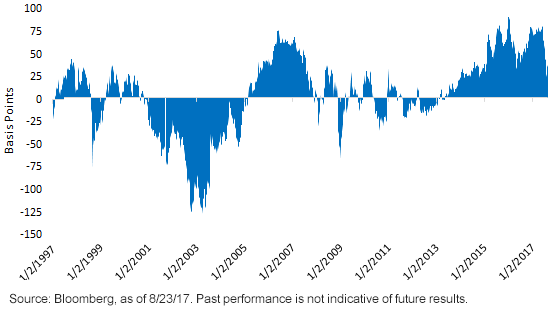
By Kevin Flanagan, WisdomTree Investments
Special to the Financial Independence Hub
With the calendar turning to September on Friday, we’re all sitting back and lamenting the end of another summer. Well, for fixed-income investors, any possible summer doldrums could quickly change, as a number of potentially headline-making events are looming directly ahead, specifically on the central bank front. While the markets do not appear to be anticipating any surprises, the next few weeks look to be busy.
 For the G5 developed market world, the Bank of Canada (BOC) is set to kick things off next week with its formal policy meeting, slated for September 6. After hiking the overnight lending rate by 25 basis points (bps) in July (the first rate hike since 2010), expectations as of this writing are not looking for a follow-up move.
For the G5 developed market world, the Bank of Canada (BOC) is set to kick things off next week with its formal policy meeting, slated for September 6. After hiking the overnight lending rate by 25 basis points (bps) in July (the first rate hike since 2010), expectations as of this writing are not looking for a follow-up move.
Bank of Canada unlikely to move on Sept. 6
Indeed, the implied probability for a rate hike next week is at only 21.7%. It is interesting to note that an integral reason behind the July increase was the BOC’s belief that it needs to focus on future price pressures and not be complacent even though inflation readings, up to that time, had been on the soft side. Thus, when the July year-over-year inflation gauge jumped .2 percentage points to +1.2%, the policymakers may have felt some vindication. Looking ahead into the fourth quarter, the probability of a rate hike for the October policy meeting jumps to 69%.
The European Central Bank meets the following day, September 7, while the Bank of England and Bank of Japan are on the docket for September 14 and 21, respectively. That leaves the Federal Reserve (Fed) on September 20. As of this writing, market expectations not only don’t see the Fed raising rates at its next meeting, but the outlook is for no hikes at all for the rest of 2017.
In addition, the implied probability for Fed Funds Futures sees only a 27.5% chance for a move at the end of January 2018 and just under 50% through May. Rather, the focus is on the potential for the Federal Open Market Committee (FOMC) to announce the phasing out of balance sheet reinvestments at its next meeting, with the actual implementation occurring in October. However, recent comments from N.Y. Fed President William C. Dudley suggest the markets may want to rethink their rate hike odds for 2017, if the economy evolves as the Fed expects.
“Spread”ing yourself too thin?
One notable by-product stemming from the BOC joining in the Fed’s rate hikes has been a visible narrowing in the spread between the U.S. Treasury (UST) 10-Year yield and its Canadian (CAD) government counterpart (shown in the chart at the top of this blog).
To provide some perspective, this differential has declined to only +29 bps, or 55 bps below the recent peak in late May. There seems to be little doubt that this narrowing has been a function of each nation’s central bank policy outlook. As the BOC geared up for its aforementioned first rate hike (and expectations for an additional move later this year), as we highlighted earlier, the markets do not presently believe the Fed will follow suit anytime soon, and will use its balance sheet roll-off instead.
Interestingly, this spread has encountered many differing scenarios over the last 20 years. While the trend has largely been positive for the UST 10-Year over the last four years, the chart above clearly illustrates there have been plenty of periods of inversion, where the CAD 10-Year yield was actually higher than the UST counterpart. In fact, since the end of 1996, the average spread has been only +5 bps.
Conclusion
Where this spread relationship goes from here seems to depend on monetary policy. If the Fed were to raise rates at its December FOMC meeting and embark on its balance sheet normalization plan, I would suspect a rewidening could result. However, before getting to that point, given current market expectations, a further narrowing in the near term could be the more likely scenario, raising the question: could the 20-year average spread level be revisited?
Unless otherwise noted, data source is Bloomberg, as of August 23 2017.
 Kevin Flanagan is the Senior Fixed Income Strategist for WisdomTree’s Investment Strategy group. In this role, he contributes to the asset allocation team, writes fixed income-related content and travels with the sales team, conducting client-facing meetings and providing expertise on WisdomTree’s existing and future bond ETFs. Prior to joining WisdomTree, Kevin spent 30 years at Morgan Stanley, where he was most recently a Managing Director. Kevin has an MBA from Pace University’s Lubin Graduate School of Business, and a B.S in Finance from Fairfield University.
Kevin Flanagan is the Senior Fixed Income Strategist for WisdomTree’s Investment Strategy group. In this role, he contributes to the asset allocation team, writes fixed income-related content and travels with the sales team, conducting client-facing meetings and providing expertise on WisdomTree’s existing and future bond ETFs. Prior to joining WisdomTree, Kevin spent 30 years at Morgan Stanley, where he was most recently a Managing Director. Kevin has an MBA from Pace University’s Lubin Graduate School of Business, and a B.S in Finance from Fairfield University.
Important Risks Related to this Article
Fixed income investments are subject to interest rate risk; their value will normally decline as interest rates rise. In addition, when interest rates fall, income may decline. Fixed income investments are also subject to credit risk, the risk that the issuer of a bond will fail to pay interest and principal in a timely manner or that negative perceptions of the issuer’s ability to make such payments will cause the price of that bond to decline.

